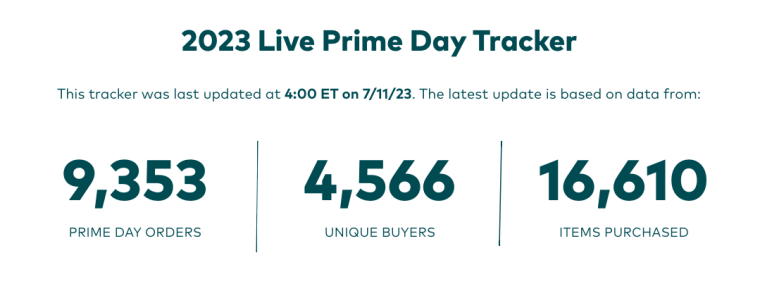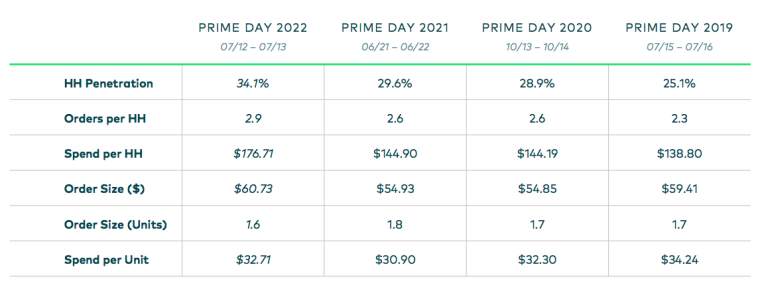
The first day of Amazon’s special sales event – Prime Day – is over and data from Numerator indicates that the shopping holiday is once again becoming a roaring success for both the e-commerce giant and its sellers.
According to the research company, the average order size during Prime Day ended the first day at $56.26 per order resulting in a 7.7% increase compared to last year’s average ticket size.
Moreover, Numerator reports that more than half of all households that are actively shopping on Prime Day have already checked out two or more orders, pushing the total spent per household to $115.23.
The same statistics indicate that 54% of all orders are valued at less than $30 while 70% of them are displaying grand totals below 50%. This may indicate that only a handful of shoppers may be buying high-ticket items such as smartphones, tablets, and robotic vacuums – a clear indication that the economic recession could be taking its toll on households’ budgets and modifying the most sought for categories on Prime Day as a result.
Also read: 90+ Amazon Statistics for 2023 – Timeline, Revenue, and Products
Women and High-Earning Households Are More Prone to Buy During Prime Day
According to Numerator, the most popular product categories are apparel, household essentials, and home goods. The assertion that consumer electronics are not on most people’s wish lists this year is affirmed by the fact that this category only made it to 12% of the verified orders surveyed by Numerator.
The majority of consumers responded that they were waiting for the items they bought to be available at lower prices (60%) while 44% said that they bought items that were listed as Prime Day deals.
The demographics of Prime Day so far this year are also interesting as women seem to be making up for 80% of all shopping activity on Amazon (AMZN) while high-earning individuals and households also accounted for 57% of the universe of shoppers who visited the site to make a purchase.
When it comes to ages, it seems that Prime Day is an appealing event for all age groups as each of the five cohorts labeled by Numerator accounted for somewhere between 17% and 20% of all buying activity.
By the end of the first day of Prime Day, 76% of all Prime Day shoppers are either “extremely” or “very” satisfied with their purchases. If this metric finishes the event at this level, it would mark a significant improvement compared to last year’s figure of 64% who shared that view.
A Recap of Prime Day 2022
Last year, households spent a total of $176.71 during the two-day shopping holiday. The average number of orders per family stood at almost 3 while the average order size was $60.73.
Back in July 2022, the number of orders with values exceeding $100 was 2% higher while 39% of households spent over $200 during Prime Day to buy different types of goods.
Amazon’s Echo devices were in high demand back then and the same goes for Blink’s and Ring’s home security products. Moreover, the e-commerce company’s consumer electronics brands – Fire and Echo – ranked first and second in terms of units sold.
One interesting difference between 2022 and 2023 is that consumer electronics were in high demand last year, with 27% of all orders containing at least one of these items. Same as this year, apparel and shoes, and household essentials made it to more than a quarter of all Prime Day orders.
Also read: US E-commerce Marketplaces Will Generate $384 Billion in 2023 Says New Forecast
In the United States alone, consumers spent nearly $12 billion during Prime Day last year. This makes the shopping holiday a major event for both the e-commerce company and its third-party vendors and can either make or break their financial projections for the year depending on how it goes.
Thus far, it seems that things are going well. Households have already spent in a day nearly 70% of what they poured into the event during the whole two days last year and that is a very positive sign. The fact that consumer electronics are not among the most popular items is relatively expected amid the state of the global economy yet other items seem to be making up for the absence of this category among top sellers.
